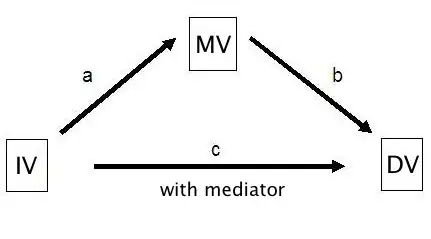I am studying the effect of economic dissatisfaction on vote for the government at the individual level. I believe this relationship is partially mediated by attitudes towards the government record. The graph below presents the relationship I hypothesise, my IV is economic dissatisfaction (five points scale), my MV is approval of the government record (dichotomous) and my dependent variable is vote for the government (dichotomous).
Given that both the MV and the DV are binary measures, I calculate all three relationships/coefficients (a,b,c) with the use of logistic regressions.
My question is: how do I calculate the total effect (the unmediated plus the mediated parts) of the IV on the DV from the logistic regression coefficients?
I checked some of literature on mediated relationships and it seems to me that had this been a set of OLS regressions, one could use the following formula:
total effect of IV on DV = (a*b)+c
Is there a similar formula I could use based on the logit models?
Thank you!
